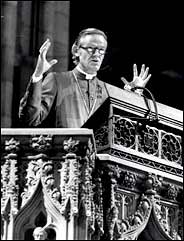Rebecca Goldstein
at Heaven’s Gate
This entry is in gratitude for Rebecca Goldstein’s
excellent essay
in The New York Times of December 16, 2002.
She talks about the perennial conflict between two theories of truth that Richard Trudeau called the “story theory” and the “diamond theory.” My entry of December 13, 2002, “Rhyme Scheme,” links the word “real” to an article in the Stanford Encyclopedia of Philosophy that contains the following:
“According to a platonist about arithmetic, the truth of the sentence ‘7 is prime’ entails the existence of an abstract object, the number 7. This object is abstract because it has no spatial or temporal location, and is causally inert. A platonic realist about arithmetic will say that the number 7 exists and instantiates the property of being prime independently of anyone’s beliefs, linguistic practices, conceptual schemes, and so on. A certain kind of nominalist rejects the existence claim which the platonic realist makes: there are no abstract objects, so sentences such as ‘7 is prime’ are false…”
This discussion of “sevenness,” along with the discussion of “eightness” in my December 14, 2002, note on Bach, suggest that I supply a transcription of a note in my paper journal from 2001 that deals with these matters.
From a paper journal note of October 5, 2001:
|
The 2001 Silver Cup Award
for Realism in Mathematics
goes to…
Glynis Johns, star of
The Sword and the Rose,
Shake Hands with the Devil, and
No Highway in the Sky.
Glynis Johns is 78 today.
“Seven is heaven,
Eight is a gate.”
— from Dealing with Memory Changes
as You Grow Older,
by Kathleen Gose and Gloria Levi
“There is no highway in the sky.”
— Quotation attributed to Albert Einstein.
(See Gotthard Günther’s website
“Achilles and the Tortoise, Part 2”.)
“Don’t give up until you
Drink from the silver cup
And ride that highway in the sky.”
—America, 1974
See also page 78 of
Realism in Mathematics
(on Gödel’s Platonism)
by Penelope Maddy,
Clarendon Press, Oxford, 1990
(reprinted, 2000).
|
Added 12/17/02: See also
the portrait of Rebecca Goldstein in
Hadassah Magazine
Volume
78
Number 10
(June/July 1997).
For more on the Jewish propensity to
assign mystical significance to numbers, see
Rabbi Zwerin’s Kol Nidre Sermon.
For the significance of “seven” in Judaism, see
Zayin: The Woman of Valor.
For the significance of “eight” in Judaism, see
Chet: The Life Dynamic.
For the cabalistic significance of
“Seven is heaven, Eight is a gate,”
note that Zayin, Seven, signifies
“seven chambers of Paradise”
and that Chet, Eight, signifies
the “gateway to infinity.”
For the significance of the date 12.17, see
Tet: The Concealed Good.




